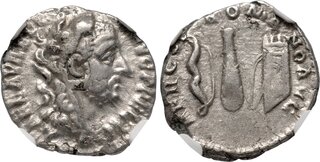Lot description:
Commodus. AD 177-192. AR Denarius (16mm, 2.80 g, 6h). Rome mint. Struck AD 192. Head right, wearing lion skin headdress / Club facing downward between bow and quiver. RIC III 253; MIR 18, 857-4/72; RSC 195. In NGC encapsulation 6291346-013, graded Ch VF, flan flaw.
From the William B. Porter Collection. Ex Classical Numismatic Group Electronic Auction 356 (29 July 2015), lot 513.
During the latter part of his reign, Commodus began associating himself with Hercules. While the Antonine emperors had traditionally associated themselves with the divine hero, Commodus appropriated the iconography more aggressively by wearing a lion skin and carrying a club, both main attributes of Hercules, and having statues of himself dressed as the god erected throughout the empire (for a bust of Commodus as Hercules, see Capitoline bust [Inv. MC 1120]; for the use of Herculean images on provincial issues of Commodus, see http://rpc.ashmus.ox.ac.uk/). The appropriation of this imagery went to apparently megalomaniacal lengths. According to Dio (73.15), Commodus in AD 190 ordered that the names of the months be changed to correspond with his name and titles – Lucius Aelius Aurelius Commodus Augustus Herculeus Romanus Exsuperatorius Amazonius Invictus Felix Pius, and that each legion replace its epithet with Commodiana. Shortly thereafter, when fire had destroyed a large section of Rome, Commodus used it as an opportunity to re-found the city as a whole and, thereby, identify himself completely with Hercules, who was considered the founder of many ancient Greek cities. Commodus ordered the restored city to be called Colonia Lucia Annia Commodiana, its citizens were now know as Commodiani, and the Senate was restyled as the Senatus Commodianus Fortunatus. All of this revitalization on his part, Commodus believed, would bring about a new Golden Age. In the autumn of AD 192, Commodus officially adopted the name Hercules; it was at this time that his portrait on the coinage began to show him wearing a lion skin. This transformation was brief, however, for, on 31 December AD 192, only three weeks after assuming the tribunician power for the eighteenth time, he was assassinated by an athlete in his bath.
Estimate: 100 USD |  |